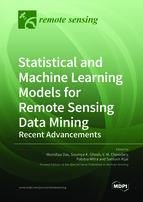Statistical and Machine Learning Models for Remote Sensing Data Mining - Recent Advancements
A special issue of Remote Sensing (ISSN 2072-4292). This special issue belongs to the section "AI Remote Sensing".
Deadline for manuscript submissions: closed (30 June 2021) | Viewed by 15706
Special Issue Editors
Interests: spatio-temporal data mining; spatial informatics; autonomous machine learning; streaming data analytics
Interests: spatial informatics; spatial web services; cloud computing; machine learning
Interests: application of geospatial technologies; multi-criteria analysis and soft computing tools for agricultural water management; integrated watershed management; hydrological modeling; land use/cover changes
Interests: machine learning; data mining; information retrieval
Interests: application of geographic information science (GIScience) in multiple disciplines; modeling and prediction of land condition; spatial analysis; ecosystem services
Special Issue Information
Dear Colleagues,
It is our great pleasure to organize a Special Issue of Remote Sensing titled “Statistical and Machine Learning Models for Remote Sensing Data Mining—Recent Advancements”.
In the past few decades, we have witnessed remarkable progressions in the field of satellite and remote sensing technologies, which have enabled us to capture high-resolution hyperspectral earth imagery on weekly, daily, and even hourly bases. This wealth of earth surface data, if analyzed effectively, can provide significant insights into various geo-spatial processes and, eventually, can help us make crucial decisions in a timely manner. However, these remotely sensed data, as continuously captured at varying spatial, spectral, and temporal resolutions, are not only gigantic, but also heterogeneous because they are generated by diverse categories of sensors using different optical/microwave technologies. Consequently, mining useful patterns/information from these enormous volumes of heterogeneous unstructured data requires enhanced data mining techniques exploiting the power of advanced computational intelligence and high-performance distributed computing paradigms. Moreover, in the context of resolving urgent issues, such as in environmental nowcasting, a timely analysis of the remote sensing data requires resource-efficient computation models with real-time processing and online analysis capabilities.
With this background in mind, in this Special Issue, we call for high-quality papers focusing on recent advancements in purely statistical as well as machine learning techniques and modern AI (artificial intelligence)-driven technologies for efficient mining of remote sensing data. The main topics of this Special Issue include the following: 1) identification of challenges and opportunities for traditional AI-driven approaches and machine learning models to mine huge volumes of available remote sensing data and 2) moving towards the development of advanced computational frameworks and learning paradigms for resource-efficient computation that can support online as well as real-time analytics of remote sensing data. This Special Issue also aims to provide a common platform for professionals, researchers, and practitioners from heterogeneous communities, including artificial intelligence, machine learning, GIS (geographical information systems), and spatial data science, to share their views, innovations, research achievements, and solutions to foster the advancement of intelligent analytics and efficient management of remote sensing data. Major topics of interest include, but are not limited to, the following:
- Advanced machine learning models for remote sensing data mining:
- Autonomous learning model;
- Supervised learning model;
- Unsupervised learning model;
- Reinforcement learning model;
- Transfer learning model;
- Deep learning
- Enhanced statistical models for remote sensing data mining:
- Theory-guided data-driven models;
- Semantically enhanced
- Intelligent techniques for efficient storage and management of remote sensing data;
- Energy-efficient processing and analysis of remote sensing data;
- High-performance and scalable computing methods for mining remote sensing data;
- Real-time processing and online analytics of remote sensing data;
- Real-world applications of remote sensing data mining:
- Climate change pattern analysis;
- Urban sprawl detection;
- Land-cover classification;
- Water quality monitoring;
- Disaster monitoring;
- Environmental damage assessment;
- Hydrological sciences;
- Agricultural applications and so
Please feel free to disseminate this announcement to any of your colleagues who might be interested.
Dr. Monidipa Das
Dr. Soumya K. Ghosh
Dr. V. M. Chowdary
Dr. Pabitra Mitra
Dr. Santosh Rijal
Guest Editors
Manuscript Submission Information
Manuscripts should be submitted online at www.mdpi.com by registering and logging in to this website. Once you are registered, click here to go to the submission form. Manuscripts can be submitted until the deadline. All submissions that pass pre-check are peer-reviewed. Accepted papers will be published continuously in the journal (as soon as accepted) and will be listed together on the special issue website. Research articles, review articles as well as short communications are invited. For planned papers, a title and short abstract (about 100 words) can be sent to the Editorial Office for announcement on this website.
Submitted manuscripts should not have been published previously, nor be under consideration for publication elsewhere (except conference proceedings papers). All manuscripts are thoroughly refereed through a single-blind peer-review process. A guide for authors and other relevant information for submission of manuscripts is available on the Instructions for Authors page. Remote Sensing is an international peer-reviewed open access semimonthly journal published by MDPI.
Please visit the Instructions for Authors page before submitting a manuscript. The Article Processing Charge (APC) for publication in this open access journal is 2700 CHF (Swiss Francs). Submitted papers should be well formatted and use good English. Authors may use MDPI's English editing service prior to publication or during author revisions.
Keywords
- remote sensing
- machine learning
- enhanced statistical model
- autonomous learning
- resource-efficient computing
- real-time data analytics
- data mining
- online learning






